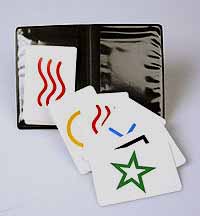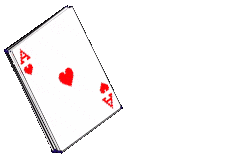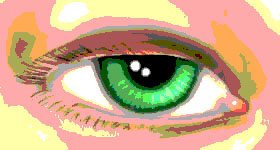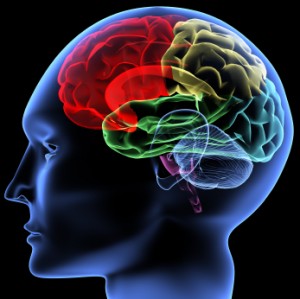CONCEPTUAL AND PROCEDURAL FLAWS IN CERTAIN
SO-CALLED ESP EXPERIMENTS
We simply list here, and discuss, the sorts of flaws that occur over and
over in almost all supposed “ESP experiments,” or “studies in
parapsychology,” which are represented as yielding “above chance”
results.
 |
INVESTIGATORS SHOW NO INTEREST IN
THE UNDERLYING PHYSICAL
PROCESSES, OR THE PHYSICAL AND PHYSIOLOGICAL BASIS OF SUPPOSED RESULTS,
IF ANY.
In no genuine field of scientific research do we find the indifference
to any question of what the actual process supposedly under investigation
is, that characterizes the field of parapsychology. Self-proclaimed ESP researchers
never seem to worry about what
physical stimulus is involved, or what part of the human body or brain
is involved, or stimulated, and how. In fact, the fundamental problem of
demonstrating directly that such a stimulus exists, independent of
whether humans can detect it or not, is completely ignored! |
|
THE EXISTENCE OF SUCH A STIMULUS WOULD NOT CONFORM TO ANYTHING
KNOWN AT PRESENT ABOUT NATURE. No
known interaction between physical
systems in nature could account in any way for the huge variety of claims made in the
parapsychology literature concerning ESP. In fact, the claims are
inconsistent with the existence of any real, physical underlying
basis. To see the problems clearly, try to imagine that there
is an “ESP machine,” something like a Walkman or iPod,
for sale at every electronics store, which when worn gives you ESP
powers. How could a single device make it possible for you to
read minds, move objects without touching them, foretell the future,
learn the contents of sealed boxes without opening them,
send your consciousness to distant locations, even other planets, find lost
objects and hidden bodies of crime victims, identify killers, etc., etc., etc.?
|
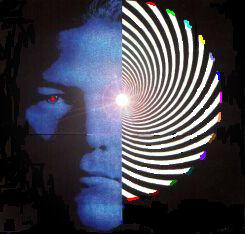 |
MOST ESP EXPERIMENTS ARE IRRELEVANT TO THE
WHOLE CONCEPT OF PERCEPTION. INSTEAD THEY ARE
“TARGET GUESSING” EXPERIMENTS.
A target guessing experiment cannot demonstrate the
existence of
a suspected channel of communication. Instead, it could only be used to study
the signal-to-noise ratio of a channel already known to exist.
[For example, over a noisy radio channel, one man could transmit a
random list of letters and another man with a receiver could write down
the letters as he interprets them through the noise. The noisier
the channel the more errors the receiver will make.]
In the absence of any concrete physical phenomenon to study, a list
comparison, with one list arbitrarily called
source and the other list receiver,
provides no information.
Suppose I have a computer generate two separate lists of random numbers
from 1 to 5 (which would not be as easy
as you might think!). If I then place the lists side
by side and compare them line by line, this comparison has precisely the
same structure as any target-guessing ESP experiment. By construction
of the experiment,
agreement between “source” and “receiver” lists, or
“target” and
“guess” lists, is due to chance.
THE ACTIONS OF THE INDIVIDUAL “RECEIVER” IN AN ESP
EXPERIMENT, IN PROVIDING GUESSES, ARE IN NO WAY CONSISTENT WITH THE USE OF
ANY CHANNEL OF INFORMATION.
For instance suppose you were asked to guess the order of the cards in a
deck of 40 playing cards (court cards removed) face down
in a box in a drawer
in some unknown room in
some unknown building on the UT campus. You would of course have no trouble
in making 40 guesses, as fast as you can call off the 40 different cards.
But consider the problem someone would face, using any conceivable real
channel of communication.
[To be concrete, imagine you have a cellphone and you have
a friend who can roam the campus at will, talking with
you continuously on his or her own cellphone. How does this
help you or your friend in any way?!?]
How do you find the building? How do you
find the right room in the building? How do you find the piece of
furniture in the room that holds the cards? How do you find the
cards in the drawer? Having located the cards, how would you
“see” their faces? You have to “see” through walls and floors,
through the
metal or wood of the desk, and through the cardboard of
the box and through the cards themselves above the
particular card you are supposedly “seeing.” Does it even make conceptual sense
to imagine a form of perception that can see through rock and concrete
and metal and cardboard, yet can see the ink on the face of the card?
After all, card ink cannot be felt or smelled or tasted. Printed symbols
are accessible to only one sense, sight. The card is just a bunch of
molecules, cardboard and ink and plastic coating. You are just a bunch
of molecules. What is the connection between one bunch of molecules, the
card, and
the other, you,
not involving vision, that could possibly allow you to
“see” the ink on a given card, near the bottom of a stack inside a desk?
And how is it that you are able to tell that you are “seeing,” for
instance, the 12th card and not the 11th or 13th? Or the 15th or the 9th?
The experiments do not appear in any way consistent with the
existence or study of any actual process, established or hypothetical.
Instead, one is simply asking the tested individual to guess.
But asking someone to guess is not the same as asking someone to
perceive in some way! If the participant were asked to write down
what he actually perceives, he would have to write down nothing.
To get any data to work with, the experimenter must always call for
mere guessing, not
perception.
EXPERIMENTS GIVE NON-REPRODUCIBLE RESULTS; EXPERIMENTS
INVOLVE DATA SELECTION, SUPPRESSION OR MANIPULATION; THE FACT THAT
HIGH SCORES CAN BE ACHIEVED BY CHANCE IS DELIBERATELY DISGUISED IN
PRESENTATION OF RESULTS.
For instance, by sheer accident an individual
might do very well in target guessing for a brief period, even though
his overall score over a long run corresponds very closely to chance
results. Instead of admitting that this is what happens, parapsychologists
tend to invent a scenario that allows them to ignore the actual
chance outcome. For example, that scores will decline after a
brief period of high scores is called “the decline effect,” and
is a supposed characteristic of ESP! If scores fall well
below chance expectations for a brief period, which is just as likely
as a brief period of high scores, this is “negative ESP,” and
still evidence of ESP! Parapsychologists often claim that
ESP is the only human ability which does not improve with
effort, concentration,
experience, exercise or training! If a person being tested
achieves scores that remain close to chance expectations
throughout, he is said to have “negative attitudes” that
are affecting his performance, or to be “deliberately hiding his
talent, for fear of ridicule.” One favorite tactic of
experimenters is to find an excuse to fail to mention average or low scores for
an individual, giving the impression that the person tested had
uniformly high scores. For instance, the experimenter might
stop the
tests when an individual's score falls to chance levels, from an accidental
above-chance start,
claiming that he is “tired” and has “lost the ability,” then
count and record only the short above-chance run.
Another tactic is, at the end of the experiment, to label the
periods of average or low score arbitrarily
as “test runs,” and count only
the high scores as “the actual experiment.” Further, individuals who get
high scores are generally never tested again, apparently for fear the scores
would then “average out.” We are often told that an individual's
scores “scared him,” and that he refuses to be tested any further!
When one makes guesses of a target, the results in the short run almost invariably
fall above or below the result expected in a very long run, and fluctuate back and
forth as the run continues, averaging to the expected long-run result.
ESP mythology is clearly simply providing a pseudoscientific (and mathematically
illiterate) framework in
which to give supernatural significance to these chance fluctuations.
EXPERIMENTAL PROCEDURES AND PROTOCOLS ARE NOT CLEARLY
DESCRIBED; OR STATED PROCEDURES ARE IN FACT NOT FOLLOWED; OR LAX CONTROLS
THAT PERMIT HIGH SCORES BY CHEATING OR SENSORY CLUES ARE MAINTAINED
THROUGHOUT, WITH THE SUBJECT ALLOWED TO CONTROL COMPLETELY THE CIRCUMSTANCES
OF HIS “PERFORMANCE.”
At times one encounters ESP experiments where the high scores are not due
to chance, but rather to cheating, fraud or collusion. The usual situation
is that an “informal” study is done, in which the tested subject is
allowed many ways to obtain the desired information. His scores are
then very high. When the “formal” experiment is begun, the loose controls
are tightened up one by one, and the subject's scores decline over the
long run to chance expectations. The experiment is then abandoned, and
the “informal” and “formal” results are averaged together, but in
the published results the impression is created that the above-chance
results were obtained entirely during the “tightly controlled” part of the
experiment. It also happens that tight controls are never actually put into
effect, and the experimenters simply lie about the situation. It also happens that
the tight controls do not apply to one person in the experiment, for
instance a data recorder or “observer,” who can then cheat to produce
high results that mystify both subject and other experimenters. More than one
ESP experimenter has been detected simply inventing all his results, without taking
the trouble to go through with the pretense of an “experiment.”
ESP EXPERIMENTS APPEAL TO THE TRUTH CRITERIA OF SCIENCE
WHILE SIMULTANEOUSLY DENYING THEIR VALIDITY.
The overwhelming majority of ESP experiments done by psychologists
since the 1920s have had reasonably adequate controls
and reasonable statistics, and have
thus found NO effects (i.e., pure chance effects). All the hundreds
of such studies are ignored and only the occasional crude early,
or deeply flawed, or otherwise invalid studies, which gave
“spectacular results,” are publicized or cited. The impression is
created that all ESP experiments give inexplicable
or exciting results, when
in fact the exact opposite is true.
PUBLICIZED RESULTS, IF FOLLOWED UP, REDUCE TO ABSURDITY.
In a famous study done by pseudoscientist
Helmut Schmidt, “evidence”
of ESP continued to exist when human subjects were replaced by cats,
and later by cockroaches! The obvious conclusion, that the high scores
were created by data selection and were independent of the subject,
was not drawn by the experimenters. Similarly, a researcher named
Walter J. Levy continued to get high ESP scores when he replaced
human subjects with egg yolks! Why not cigarette ashes? Or rocks?
Levy was later fired when he was caught by suspicious
co-workers making up his data,
but if he hadn't been caught, he'd probably still be
going strong. The experimenters themselves tend to demonstrate
unmistakably sooner or later that their procedures and results
are invalid. The “research” is then totally abandoned, without
further comment, and the original meaningless results are
allowed to stand unquestioned.
Two classic instances of such reductions to absurdity are provided
by the “retroactive psychokinesis” experiments of Helmut Schmidt and
of the Princeton Engineering
Anomalies Research Center founded by
Robert Jahn. Both Schmidt and Jahn claimed that one could record
a series of random numbers, a statistical baseline, onto magnetic tape, and that at any
time in the future someone could concentrate on biasing the
hitherto-uninspected (according to Schmidt)
or already inspected (according to Jahn) results of the experiment away from the
baseline, so that when the
tape was finally inspected (or inspected again)
the recorded results would now actually
show a bias! But if this were possible,
the results obtained in any experiment of any kind
would always be meaningless because there
could be no statistical baselines for comparison! Surely,
with the entire future before us, someone somewhere could
have concentrated and changed all the “control runs” that were used
to establish statistical baselines!
In fact, Schmidt and Jahn should
never have obtained positive results, because I
personally have mentally focussed
for years on setting their non-chance results back to pure chance!
Also,
if it is possible to mentally affect information recorded on magnetic
tape or disk, it should be equally possible to affect the
printed texts of articles, to cause even them to change from
positive (above-chance) results to pure chance results! Indeed,
parapsychologists frequently do blame the large number of skeptical
scientists for the very small “above chance” results seen in such
experiments. A powerful psychic is clearly needed to offset
even slightly the negative
thoughts of thousands of “white-coated, atheistical materialist”
scientists.
Such considerations are so childishly ignorant, hopelessly absurd and
internally contradictory that one feels like a fool even
mentioning them, but parapsychologists, far from being shamed, find
such considerations to be “the most exciting aspect of parapsychology.”
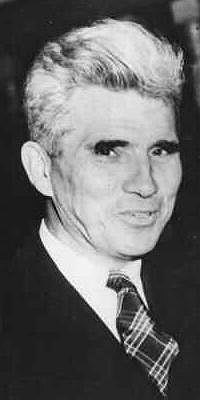
The typical bungling ESP “researcher,”
J. B. Rhine
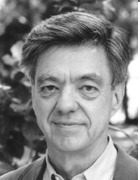
Scientologist and ESP “researcher,”
Hal Puthoff
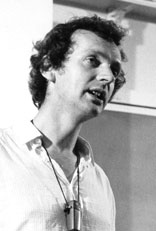
The typical bungling ESP “researcher,”
Rupert Sheldrake
(Click on each image for more information)
|
THE TRADITIONAL CATEGORIES OF ESP
PHENOMENA ARE
NOT DISTINGUISHABLE AND DO NOT MAKE SENSE. ESP PHENOMENA ARE
DEFINED NEGATIVELY. The phrase “ESP”
can mean almost anything, for instance: telepathy, or reading the mind
of another; clairvoyance, or seeing without the use of the eyes;
precognition, or awareness of future events before they
take place; astral projection, or the ability to send
one's consciousness outside the body to distant locations;
and psychokinesis, the ability to move or otherwise somehow affect
external objects and phenomena by mental concentration.
The problem with this labelling can be seen by asking, if someone
draws a card, looks at it, and asks me to guess it, and if
I get it right, did I use telepathy, or clairvoyance, or precognition,
or astral projection? Or did I get it right by chance?
If someone draws a card, does not look at it,
and asks me to guess it, and if I get it right, did I use
clairvoyance, precognition, astral projection, or what?
Or did I get it right by chance?
If I correctly guess the contents of a sealed metal box, did
I use telepathy, clairvoyance, precognition or astral projection?
Or did I get it right by chance, or by some sneaky magician's tactic?
If I decide to try to use psychokinesis to “bias” a random number generator
toward the number 4, and later when the results are examined 4 does
come up more often, did I use psychokinesis or did I use precognition?
Or was there something wrong with the “randomness” of the
generator?
And so on!
The fact that the ability to be tested is not defined in any
meaningful way makes the test inherently meaningless, no matter
how carefully it is done. If I appear to possess any information
that the experimenter doesn't think I could have obtained,
no matter how I actually obtained it, this is ESP!
The phenomena are defined negatively. But absence
of knowledge about how information was obtained cannot be
made the basis of an argument for the existence
of new ways of obtaining
information!
This is the familiar pseudoscientific technique of argument from
ignorance. If you don't know, and make no effort to find out, you are
stuck with the conclusion that you don't know, and there is no way
without further effort to go beyond that lack of information.
|
Three types of ESP experiments that have been done very often in the
past two decades are (1) “ganzfeld” tests, (2) “random number
PK” tests, and (3) “remote perception” tests.
These are worth discussing in more detail since most
current bogus ESP studies fall into one or another
of these categories.
|
In the “ganzfeld” tests [the
German phrase
translates roughly as “single object” (of concentration)]
subjects are isolated from “ordinary” sensory inputs.
Eyes are covered, ears are fed white noise through headphones, and
the subjects recline on soft beds, in isolated, perfumed rooms.
While “senders” elsewhere look at pictures or patterns,
supposedly chosen randomly from a set, the subjects describe into a
tape recorder whatever pops into their minds. After 30 minutes or
so, the subjects are shown all the pictures in the set and asked
which pictures match their recorded imagery. If more matches occur
than would be naively expected by chance, this is proclaimed
“evidence” of ESP. The role of subjective validation in
matching actual specific pictures to unrelated, vaguely-reported imagery should be obvious,
and is rarely absent at any moment from such studies. |
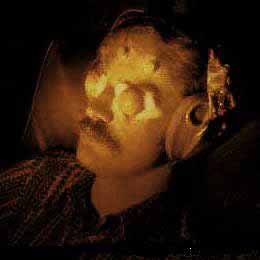 |
In the “remote perception” tests, experimenters visit a variety of
locations, while subjects in the lab attempt to “see” the remote
location as if through the eyes of the experimenters. In reality,
this is just a disguised version of the usual target-guessing experiment.
And again subjective validation runs rampant in deciding which actual
location is a match for which vague and ambiguous description.
No one who has carried out such studies with claimed above-chance results
seems even vaguely aware of double-blind protocols.
In the “random number PK” experiments, random numbers are supposedly
generated by a computer, or some mysterious electronic device,
while subjects attempt to “bias” the
outcome in some way, for instance by concentrating on a specific
number. If the target number comes up more often than “chance”
would indicate, this is proclaimed evidence of
“psychokinesis” (PK).
Yet, by construction of the experiment, the only thing being studied is the
bias inherent in the random-number generator itself. However, the situation
is sometimes more subtle than this, and is worth an extended discussion.
RANDOMNESS IS THE KEY!
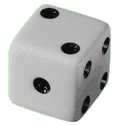 |
Note the basic problem remains in all three of these studies. One is
just looking for correspondences between two supposedly
“random” lists of items. If more correspondences consistently
show up than chance would indicate, and there is reasonable survelliance
against cheating, the most likely hypothesis
is that the lists are not actually random.
|
|
In recent years, psychologists have realized that the issue of randomness
is a key issue in almost all reported ESP experiments. In the
“ganzfeld” experiments, note that people asked to choose pictures
or patterns from a set will not choose randomly, but will be influenced
by various psychological biases. Such biases will affect both
“senders” and “subjects.”
Again, lists of sites to visit will not likely be chosen truly
randomly from the set of “distinctive” locations within easy driving
distance of the laboratory.
Again, suppose a computer is used to prepare a list of random numbers,
and the pictures are matched against the numbers in order to
“shuffle” them randomly before they are given to the
“senders” or “subjects.” How do we know the list of numbers
generated by the computer is genuinely random? In fact, the
generation of truly random numbers via computer remains an
unsolved problem. All widely used methods of generating strings
of “random” numbers, such as the FORTRAN function
RAN(X), available during the 1960s through the 1980s, yield only pseudo-random numbers. If the set of
numbers generated is large enough, subtle patterns emerge.
When such patterns happen to favor psychologically appealing pictures,
the ganzfeld experiments can give seemingly inexplicable results.
Similarly, if the remote viewing sites are in any way stereotypical,
the rambling descriptions of the subjects can be matched in some way
in most cases. Only very recently has some progress been made in the actual subsequent
“randomization” of pseudorandom numbers initially generated by computers
or other similar electronic means.
The fact that “random number generators” do not in
fact generate random numbers is the basis of the operation of the
tiny remote transmitters
that everyone uses to lock and unlock his or her car. Starting with the same initial number, both the
receiver's generator in the car and the transmitter's generator in the remote
control generate precisely the same “random number”
from it, a unique code for that particular transmitter-receiver combination! |
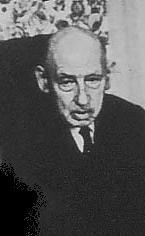
Prof. S. G. Soal, a mid-century
ESP researcher who notoriously fabricated all his “above chance” results.
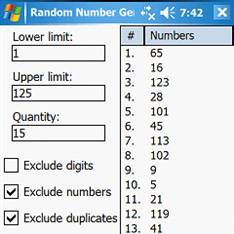
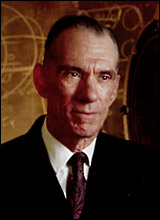
Robert Jahn |
Note how the same problems emerge with the “random number PK”
experiments. The numbers generated by the computer are not actually
random. It is equally as important to
realize that people asked to generate a string of random numbers
generally cannot do so. For example, if asked to generate a string
of random numbers from 1 to 5, most people will not follow a
4, say, by another 4, because this “is not random.” But in fact
a 4 should be followed by another 4 one time out of five.
Such ignorance affects experimenters as well as subjects.
For example, one of the immortal “Three Stooges” of ESP
research, Charles Tart, once had a random number generator
that lit one of four colored lights, red, green, blue and yellow.
When he found the random number generator often (hopefully one time out
of four!) lit a red light again after a red light had just been lit,
for instance, he rewired the circuits so each successive light
was guaranteed to be a different color from the one before!
Where a pattern in the pseudorandom “target list” happens to
match a pattern in the lists generated by the experimental
subjects (e.g., the chosen “targets” they select “randomly”
to attempt to bias the generator toward), above-chance results
will occur.
There's a good discussion of these questions by British psychologist
Susan
Blackmore [see New Scientist, Sept. 22, 1990].
She gives many examples of psychological tests conducted by herself and
others that reveal the poor understanding of the concepts of probability
that most people have, and how such misunderstandings are relevant
to ESP experiments.
ESP experimenters have long divided subjects into two groups,
“sheep,” who do well on ESP tests, at least initially, and
“goats,” who score poorly (i.e., at chance level) from
the beginning.
Blackmore points out that in experiments done
by psychologist
Peter Brugger at the University of Zurich, he
divided subjects into “sheep” (who had a poor comprehension of
probability and randomess) and “goats” (who had at least a fair
understanding). He found that the sheep created patterns,
“response bias,” in their
guessing which were generally avoided by the goats. In the
opinion of Brugger and Blackmore, this single fact explains most of
the major findings of the pseudoscience of parapsychology.
For instance, children are claimed to do better at all ESP tests
than adults--- and Brugger found children always
show more response bias than adults. Similarly extroverts are
claimed to score consistently better than introverts--- and
extroverts consistently display the most response bias.
Similarly, mentally disturbed, retarded or brain-damaged individuals
are alleged to score consistently better--- and show the most
response bias. Finally, even the “decline effect” is
explained on this basis. It is found that high ESP scores tend
to decline even when the experiment is automated to rule out
arbitrary data selection--- and Brugger found that
response bias
always
tends to decline from an initially high level
as the subjects grow bored or fatigued and get careless about
“making it really random.”
In her own studies,
Susan Blackmore also found that the well known inability to guess
probabilities correctly plays a major role in convincing individuals
they have ESP.
Probabilities are almost always underestimated.
For example, she asked subjects to play a game in
which they should get 10 correct responses by chance. Her
“goats” correctly estimated that they should get 10 hits, but
her “sheep” estimated that “chance” would give an average
7.9 correct responses. Thus, a sheep who got his expected
10 hits would, in Blackmore's words, “think he had done very well
and look for an explanation. Obviously no reasonable explanation
will be found since only chance was operating. So the obvious leap
is to the paranormal,” and to ESP.
Of course, many other flaws of thinking that we have
discussed in the class play a role as well.
A woman who thinks she is
using psychokinesis to find parking places in a crowded lot will
count the times she only has to circle a few times before a place
opens up as successes, and
simply ignore the times she had to circle for
many minutes.
PSEUDOSCIENTISTS WORK WITH THE NOISE,
NOT WITH THE SIGNAL
Note that the crucial question in most ESP experiments, where no other
flaws happen to be present, is the question of whether a random list
is truly random, i.e., whether noise is really noise. Imagine how
far radio would have progressed since the turn of the century, if
experimenters had ignored the design and building of powerful transmitters
and receivers, and instead tried to show that some primitive, impossibly
feeble transmitter was actually transmitting to some impossibly
insensitive receiver by making a study of the static and noise output
of the receiver, and trying to show that, at a level very slightly
above chance, the static or noise in the receiver happened to correspond
sometimes, maybe,
to the feeble pulses of the transmitter! Radio would still be a
laboratory curiosity, with great debate and doubt among scientists
as to whether or not it even existed. Sound familiar?
Scientists can make real, rapid progress with real phenomena.
Research into ESP began in the 1880s and 1890s, about the same
time as research into electromagnetic radiation. In the next
century, the world was utterly transformed by scientific and
technical applications of electromagnetic waves. Where is ESP?
Still in the lab, still looking at the noise and pretending to find
signals. Based on what we have learned in this course, it seems
unlikely that ESP experiments will ever reveal any actual,
existing phenomenon of any sort, currently unknown to science.
Links:
Skeptic's Dictionary: ESP
Skeptic's Dictionary: Parapsychology
Skeptic's Dictionary:
extraordinary human functions
2000 Interview with Joe Nickell
``Psychic
Illusions,"
by Susan Blackmore.
A former "psychic" on psychic ability.
Another one bites the dust!
Want to learn how to move pieces of paper,
or even huge pieces of lumber, by the
mystical powers of the unknown mind? Or something? It's free!
Suggested Reading:
“Extrasensory Perception,” by J.
E.
Alcock, in Encyclopedia of the Paranormal, ed. by Stein, G.,
Promethus, NY, 1996.
Secrets of the Psychics, Massimo
Polidoro (Prometheus, NY,
2003).
Pseudoscience and the Paranormal, Terrence Hines
(Prometheus, NY, 2003).
Guidelines for Testing Psychics, Richard Wiseman
and
Robert L. Morris
(Prometheus, NY, 1995).
Psychic Sleuths, ed. by Joe Nickell (Promethus, NY, 1994).
The Illusive Quarry, Ray Hyman (Prometheus, NY, 1989).
The Search for Psychic Power: ESP and Parapsychology Revisited,
C.E.M.
Hansel (Prometheus Books, NY 1989).
Parapsychology: Science or Magic?, James Alcock (Pergamon,
NY,
1981).
The Psychology of the Psychic, David Marks and Richard
Kammann
(Prometheus
Books, NY, 1980).
Enhancing Human Performance, Part III, "Parapsychological
Techniques,"
National Research Council, ed. by Daniel Druckman and John A. Swets
(National Academy Press, 1988).
The Adventures of a Parapsychologist, Susan Blackmore
(Prometheus
Books,
NY 1986).
Flim-Flam! James Randi (Prometheus Books, NY 1982).
Leaps of Faith, Nicholas Humphrey
(Copernicus/Springer-Verlag, NY, 1996, 1999).
"Science and the Supernatural", George R. Price, Science 122
(1955):
359-67.
"Investigating the Paranormal," by David F. Marks, Nature 320, 13
March
1986, 119 - 124. [One of the best articles of its kind!]
"Psychic Sleuth Without A Clue," Joe Nickell, The Skeptical
Inquirer,
28, No. 3, May/June 2004, 19-21.
Astrology!
Avoiding Facing Death!
Blavatsky, Queen of Pseudoscience!
Cities on the Moon and Mars!
Creationism and Intelligent Design!
Distinguishing
Science from Pseudoscience!
ESP!
Flying Saucers (1947–1985)
Fortean Phenomena
The Fourth Dimension?!?
Ghosts
Gods
from Outer Space!
Hollow Earth!
Interstellar Travellers!
Kirlian Photography
and the Aura!
Martian Canals!
Medical Quackery!
Monsters!
and
Ape Suits!
Mystery
Spots?
Mystical and Bogus Physics!
The New Age!
Pareidolia!
Postmodernism vs. Science!
Prophecy and Prophets!
Psychic Detectives!
Pyramid and Crystal
Myths and Powers!
Science Fiction and
Pseudoscience!
Space Brothers!
Spiritualism!
UFOs 1985-2005!


